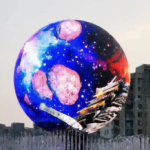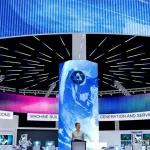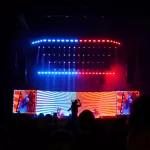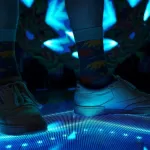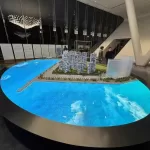The Complex Brilliance of Ring LED Screens
LED displays are evolving rapidly. Among them, ring LED display systems stand out for their captivating visual effects and immersive 360-degree layouts. These circular or semi-circular configurations are now widely used in shopping malls, sports arenas, stage backdrops, and experience centers.
However, their unique structure brings significant maintenance challenges. Unlike traditional flat panels, ring displays involve curved frameworks, tight module interconnections, and hard-to-access installations.
Despite these difficulties, manufacturers and integrators have developed effective strategies. Through thoughtful design, modular engineering, and smart diagnostics, many of these hurdles are now manageable.
1. Structural Complexity and Its Consequences
Circular LED screens must follow a non-linear geometry. Modules in ring displays are either arc-shaped or segmented. While this design delivers impressive aesthetics, it complicates several aspects of upkeep.
Primary Issues:
Non-standard panel shapes require custom parts.
Tight module curvature restricts hand access.
Mounting systems are often suspended or ceiling-mounted.
These design factors hinder module removal, part replacement, and cable servicing.
However, through precision design and magnetic fixing systems, installers can improve accessibility. Using modular arc panels, technicians can detach and replace units without full disassembly.
2. Cabling Challenges in Circular Configurations
Another major issue involves cabling. In a ring layout, data and power cables follow a radial or concentric pattern. These arrangements increase the risk of:
Overlapping cable bundles
Signal interference
Loose connector points due to curved tension
To address this, professional ring LED display systems now employ daisy-chain topologies with shielded connectors and reinforced strain reliefs. Moreover, labeled cable routing and quick-release connectors enable safer, faster service.
In addition, fiber-based signal transmission reduces latency and loss, especially in large-diameter ring installations.
3. Difficulties with Heat Dissipation and Ventilation
Heat buildup is another maintenance concern. Because many ring LED systems are suspended or embedded, airflow is restricted. Over time, poor ventilation leads to:
- Thermal stress on LED chips
- Degraded brightness uniformity
- Shortened component life
Leading manufacturers now incorporate active cooling and aluminum alloy backframes that improve heat conduction. Some systems even employ micro-fans or embedded vents within the ring structure.
Thermal monitoring chips allow automatic shutdown or throttling during overload conditions, extending display lifespan.
4. Diagnosing Faults in a 360-Degree Installation
In traditional flat LED displays, identifying a dead pixel or failed module is easy. However, with ring LED display systems, faults may occur at the top, rear, or under lighting trusses.
Without proper diagnostics, technicians must manually inspect large circular surfaces—a time-consuming task.
To solve this, smart control systems with built-in diagnostics are implemented. These platforms allow:
Remote pixel testing
Module health monitoring
Real-time alerts on voltage, current, or temperature anomalies
Technicians receive exact fault locations through software dashboards, greatly reducing inspection time.
5. Maintenance Accessibility: Height and Mounting Issues
Many ring displays are installed above stages or in central atria. Their mounting positions pose risks during maintenance.
Common issues include:
Need for scaffolding or lifts
Limited working space
High-risk disassembly in live environments
Magnetic mounting systems, rear-access panels, and pre-angled brackets now help minimize risk. Moreover, telescopic arms and rotating base structures provide controlled lowering for ground-level servicing.
6. Synchronization and Control Failures
In 360° or curved configurations, synchronization of video signals is crucial. Faults in control cards or mismatched calibration files lead to:
Visible tearing or flicker
Inconsistent brightness zones
Content lag between segments
Today’s ring LED display systems use redundant signal inputs, automatic calibration, and real-time sync correction algorithms to prevent visible errors. If a controller fails, the backup controller takes over instantly.
Regular software updates and configuration backups further ensure smooth operation.
7. Cleaning and Optical Maintenance
LED modules collect dust and residues over time. In ring screens—especially ceiling-mounted types—cleaning becomes difficult.
Dirty surfaces lead to:
Diminished brightness
Reduced color fidelity
Uneven light diffusion
Dry microfiber tools, telescopic cleaning poles, and anti-static sprays help mitigate these issues. Some advanced systems include nano-coating treatments that repel dust and oil.
Regular cleaning schedules, based on environment (indoor vs. outdoor), are essential for visual clarity and module health.
8. Spare Part Management
Since ring modules are custom-designed, standard replacement parts may not apply. This creates issues:
Supply chain delays
Mismatched segments
Color or pitch inconsistencies
To resolve this, professional suppliers like D-King offer spare module kits specifically calibrated to the original system. Serial-matching ensures pixel and brightness consistency across replaced segments.
9. Training and Technician Preparedness
Ring LED displays require skilled maintenance teams. Unlike basic flat panel repairs, technicians must:
Understand curvature-related stresses
Work safely at heights
Use software-based diagnostic tools
D-King provides training programs, remote support, and user manuals tailored to ring systems. With the right preparation, clients handle minor repairs in-house and escalate only complex issues.
10. Long-Term Reliability through Design Excellence
Ultimately, the best way to reduce maintenance demands is through thoughtful design. Leading systems feature:
Pre-curved LED modules
High IP-rated enclosures (IP65 and above)
Anti-oxidation protection for connectors
Reinforced brackets and locking systems
Real-time fault tracking software
By designing for reliability from the start, maintenance becomes predictable and budget-friendly.
Conclusion: Mastering Ring LED Display Maintenance
Maintaining ring LED display systems poses unique challenges—from structural complexity to limited access. However, as we’ve explored, these issues are solvable through:
- Smart mechanical design
- Modular architecture
- Advanced diagnostics
- Environmental protections
- Professional training and support
With over a decade of experience, Д-Кинг offers fully integrated ring LED display solutions. Our systems balance visual impact with serviceability, ensuring long-term performance in demanding environments.
By choosing D-King’s ring LED display systems, clients gain both innovation and operational confidence, without compromising on aesthetics or function.

